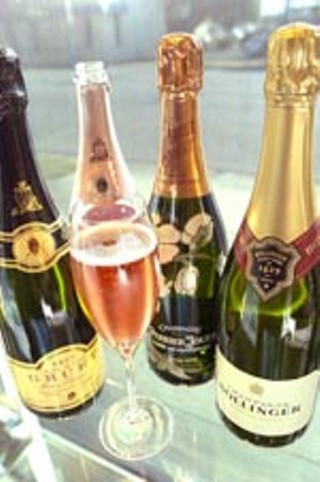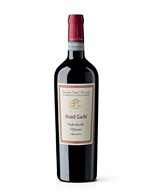Tasting the Stars
Champagne: An appreciation and primer
By Wes Marshall, Fri., Dec. 31, 2004

It's time again for the annual ritual of popping a bottle of bubbly wine to celebrate the new year. While we're all for any rite that includes wine, we wanted to take a step back from the rush of the holiday season and ponder what goes into making the wine that caused the old monk Dom Perignon to exclaim, "Come quickly, I am tasting the stars!"
I've had the opportunity to taste a lot of Champagnes and sparkling wines this year, and later I'll share my favorites, but for the newcomers, let's cover a few basics. First and dearest to the heart of the folks who live in France is the fact that for a wine to be Champagne, it should come from Champagne, the area around Reims and Epernay in the eastern part of the country. Any other bubbly wine should be called a sparkling wine. There is no disgrace in being a sparkling wine, and frequently they cost a good deal less than Champagnes. But the microclimates make a world of difference in the flavors of wines, and the microclimate (what the French call terroir) of Champagne is ideally suited for sparkling wine.
Still, the key issues are how the wine is made to sparkle, and what grapes are used to make it. Have you ever been to a wedding where they are serving some off-brand of sparkling wine and woken up the next day with an elephant sitting on your head and the flames of hell billowing out of your belly? You can probably thank one of the cheaper ways of making wine bubble. Sadly, most of what is sold this New Year's will be made by taking sweet wine and carbonating it. Wine conglomerates use this process because it is dirt-cheap, but please, avoid the stuff. How do you tell if it is carbonated? If it is not, it will say either Charmat, Methode Champenoise, or Champagne on the label. Charmat is a process whereby the winemaker puts grape juice in large tanks and lets the carbon dioxide from fermentation produce the bubbles. It is a little better than carbonated (occasionally much better, but trust your salesperson), but for just a little more money you can step up to the gold standard, Methode Champenoise.
This is the method used in Champagne, and anyone claiming to make a good sparkling wine generally adheres to the basic tenets the French use. Grape juice is fermented into wine, then a combo of sugar, wine, occasionally brandy, and sometimes a couple of other secret ingredients (altogether called the dosage) are added to the wine, along with more yeast, and the whole blend is bottled and corked. The yeast and dosage create a second fermentation, which throws off carbon dioxide. Since the gas has no place to go, it mixes with the wine and creates the luxurious bubbles we associate with Champagne. During this phase, the wine throws some sediment, so the winemakers developed an Occupational Safety & Health Administration inspector's nightmare wherein each bottle is angled, neck down, at about 45 degrees from the ground, and some poor person who is trying to learn how to make wine gets stuck with the job of going into the cellar and twisting each bottle a fraction of a turn each day to encourage the sediment to go down into the neck.
When the winemaker is satisfied that the wine is ready to drink, he brings the bottles out, pops the tops, puts in another dosage to bring the wine to the sweetness he is searching for, and reseals them immédiatement. Note that I glossed over two important points: First, any wine made using Methode Champenoise is ready to drink when it hits the store shelves; you don't have to worry about saving a wine. Second, these wines come in different levels of sweetness and, just to make things nice and confusing, of the two levels you'll see most often, extra-dry is the sweeter and brut is the dryer.
Besides how the wine is made, the other key issue is which grapes are used. In Champagne, the classic combination is Chardonnay and Pinot Noir, though you'll sometimes see Blanc de Blanc (made only from Chardonnay) or Blanc de Noir (made from Pinot Noir). In the United States, most sparkling wines use the same grapes, but the wines from Italy and Spain, the two other dominant producers we see here in Texas, use local grapes like Prosecco or Macabeo. These aren't necessarily worse than using Chardonnay and Pinot Noir, except for one issue: They don't age as well, so if you want to buy a sparkling wine from Italy or Spain, go to a reputable wine merchant and ask for something fresh.
That being said, you can find some wonderful wines from either country here in Central Texas. Spain makes the less expensive wines, and the ubiquitous Freixenet Brut Cordon Negro is a perfectly serviceable wine made using the Methode Champenoise; it's often available for less than $8. A little bit harder to find, but worth the search, is Cristalino Brut, which will cost about a dollar more. Both wines have a biscuits-and-citrus flavor that goes nicely with food.
The Italians have been letting the cost of their Proseccos drift up with the Euro, and they aren't quite the bargain they once were. Still, there are a few bargains around. Mionetto is the hot brand right now, and my favorite of their wines is Il, which comes with, no kidding, a beer bottle style crown cap. The wine is delicately bubbled, what the Italians call frizante, and goes down so nicely that you'll want to either nurse your glass or buy a lot. It should run about $12. Another great low-cost Italian wine available locally, and only in Texas, is Balestri Valda Soave Brut Spumante, a delicious wine with light almond and green apple aromas that costs about $16.
We produce a number of tasty sparkling wines in the United States, also. Over the years, I've recommended Gruet Blanc de Noirs several times, but it bears saying again: At $12, this is the best sparkling wine per dollar made anywhere in the world. And it's from New Mexico! If you would rather feed the Schwarzenegger economy, Domaine Chandon is making reliably great wines, especially the lusty Blanc de Noirs. A bottle will cost about $16, which means that, for $28, you can try two great American Blanc de Noirs and find out for yourself what effect climate has on the taste of wine.
Best for last, and sadly, in spite of the efforts of winemakers worldwide, the finest stuff still comes from Champagne. I say sadly because the prices skyrocket when that magic word appears on the bottle. Oh, you can find a bargain here and there for $25 (see "Choice Champagnes Around Town," below), but to get a really good bottle of Champagne, be prepared to spend some money. Well, there is one exception. One of my favorite Champagnes, Pommery, comes in a cute little .187 liter bottle (that's one-fourth of a bottle), and it even comes with a straw. Apparently the bars are selling these things by the gazillions, and I have to admit, they are cute. Look for a little bottle with POP blazed across, and plan on paying about $11. In the regular-sized bottles, I'm nuts over Nicolas Feuillatte Rosé ($36), a robust Champagne with dark berry aromas and the most gorgeous salmon color. Or, if you really want to make a splash at your next tête-ã-tête, pop open a bottle of Perrier Jouet Fleur de Champagne Rosé. Be sure to carry your platinum card as you search it out – it runs more than $150, but the taste is celestial.
Thankfully, my favorite Champagne of 2004 was a little less. Champagne Bollinger Special Cuvée has been around since 1911, when the makers decided that the term "nonvintage" wasn't good enough for their, uh, nonvintage. A rose by any other name, and all that, but, after all, it doesn't really matter what they call it, it matters how it massages your senses. Bollinger's cuvée is mostly Pinot Noir, lending a rich dark berry flavor, and they use a very small dosage, which allows the subtle characteristics of the Chardonnay and Pinot Meunier grapes to come through. What you get is an explosion of complex flavor that keeps giving joy to your world for several minutes after each delicious sip. Given the fact that the prices of some of the Champagnes I tasted this year ran into the stratosphere, the fact that Bollinger's Special Cuveé costs $60 seems like a miracle.
Whatever your drink of choice, have a happy new year. I'll leave you with my favorite quip about Champagne from the ever-hip Dorothy Parker:
Three be the things I shall never attain:
envy, content and sufficient champagne.








